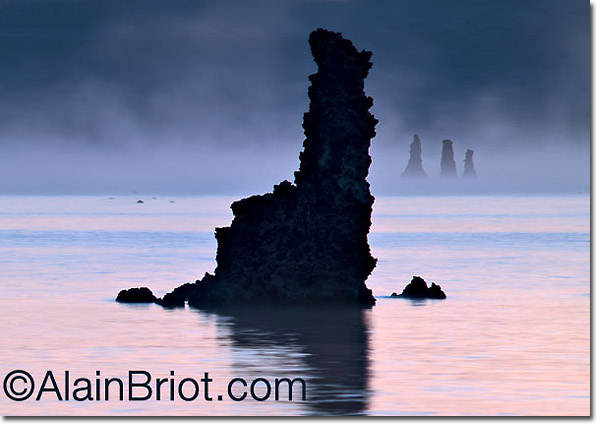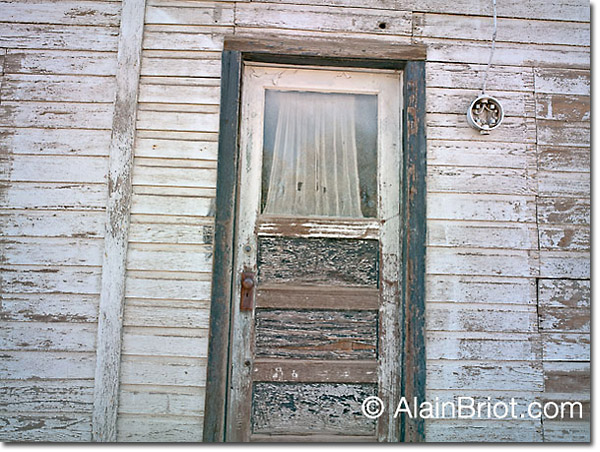What is Fine Art Photography? Part 2 of 3 |
Clean out a corner of your mind and creativity will instantly fill it. - Dee Hock
B – Fine Art Photography: The Technical Aspects
1 – Post-processing is a requirement in order to express the artist's vision.
The camera sees and records images differently than we see. Furthermore, the camera is a machine, not a thinking, feeling human being. Therefore, in order to express an emotional response to the scene or the subject through our photographs, we must step in, so to speak, and modify what the camera "saw" and recorded. We cannot pretend to create art by simply pressing the shutter button and letting hardware and software alone produce the final image and print.
This "stepping in" means that we must apply post-processing to the photograph. The term post-processing is somewhat antiquated and can be misleading. A remnant of the film days, it refers to what was done to a photograph after the film had been developed—i.e., processed—in the lab. What was done back then was done optically and chemically, during the development of the film, the exposure of the photographic paper in the enlarger, and the processing of the exposed paper in the developer, fixer, and toner.
Today "post-processing" continues to be done even though there is no longer any processing involved. Instead, the RAW file is converted into an RGB photograph in the RAW converter, then optimized, enhanced, and adjusted in the computer using what has become the fundamental photographic processing software, Adobe Photoshop, or some other image editing software.
To those who are unfamiliar with fine art photography, Photoshop processes are often grouped under a single term: manipulation. This term is sometimes used in a derogatory fashion to indicate that an artist went beyond the boundaries of what should be done to a photograph. My purpose here is not to argue against the use of this term or its implications. I did so in other essays I wrote on this subject and at this point I consider the matter closed and unworthy of further attention. What I do want to point out here is the absolute necessity of applying some amount of post-processing to every photograph in order for the image to express the artist's emotional response to the subject.
The reason for this is simple: there is no other way to express your emotional response to the scene or the subject that you photographed. If you leave the image as it came out of the camera, what you have is how the camera "saw" and recorded the scene. In order to add what you experienced emotionally to what the camera captured technically, you must post-process the image, meaning you must use image conversion and image processing tools to express your vision.

Four Tufas at dawn, Mono Lake, California
The tonality, contrast, color palette, and image format of this photograph were modified from what they were when it was recorded by the camera. The motivation for these modifications was to express what I saw and felt when I experienced this scene. As an artist I see what the camera captures as a point of departure, not as an end in itself. The image is complete only after I have modified what the camera captured so that it shows what I experienced.
2 - A fine art photograph demonstrates technical mastery.
In order to perform post-processing so that the result is a fine art image, the finest techniques must be used. Because fine art photography emphasizes quality rather than quantity, the emphasis on quality must be present not only in the post-processing of the image but also in all aspects of the creation of the piece. These include image capture, processing, printing, matting, framing, and all the other technical steps involved in the creation and completion of the work.
Because digital photography is changing constantly, and because new equipment and new techniques are introduced all the time, the artist must continually seek to refine his technical skills and keep up with new techniques and equipment through regular study and research.
3 – Technical mastery is placed at the service of artistic inspiration.
In fine art photography technique is not an end in itself. Therefore the goal is not to develop technical mastery for its own sake.
Mastering technique without mastering art results in the creation of technically perfect images in which inspiration, vision, and personal style are lacking. Technical mastery results in making technically excellent photographs, but not necessarily artistic photographs. This is because art is not just about technique. Good art implies good technique, but using good technique alone does not result in the creation of art. To be considered art a photograph must be both technically excellent and artistically inspired and inspiring.
Of course, technical mastery has to be considered within the context of the artistic movement that a specific artist is working in. What that mastery entails will therefore vary. For example, with reportage-type images, blur or movement is often part of the work and not considered a flaw. On the other hand, with photographs that follow the tenets set forth by the f-64 art movement, sharpness throughout the entire scene is expected and any blurring is seen as a flaw. Each type of image, each art movement, calls for a specific technical approach. What is considered to be a mistake for one movement may be purely intentional for another movement. Therefore, the technical quality of a fine art photograph can only be assessed in the context of the technical tenets of the art movement that a given artist belongs to. The topic of art movements is addressed more thoroughly later in this essay.
4 – A fine art photograph is printed and signed by the artist.
The work must be printed by the artist, or by a master printer under close supervision of the artist. Machine prints done by high-volume labs offering low prices and quick turnaround times cannot be considered fine art.
A fine art print must be done on high quality paper and the paper must be chosen specifically for the type of print desired by the artist. The print needs to be mounted, matted, and framed to archival museum standards. As we saw previously, only the finest materials must be used.
The photograph may be numbered, though releasing photographs in a numbered edition is not a requirement for fine art categorization. However, if the artist numbers his prints he must demonstrate impeccable integrity and record-keeping in his practice of the numbering process.
Finally, the print needs to be signed by the artist. The presence of the artist's signature indicates that the artist personally inspected the print and approved it. It shows both provenance and pride on the artist's part.
5 – The photographer retains the right to print the image differently over time.
Each new print from a specific photograph reflects the vision of the artist at a specific time in his or her life. As such, the same photograph may be interpreted and printed in different ways throughout the artist's career. As a result, prints of the same image made by the artist during different periods of his career may reflect different visions for the image and may therefore look quite different from one another.6 – The print warrants an extended analysis, enjoyment, and display.
The final goal of the fine art photography process is the creation of a print that is meant to be enjoyed for many years. A fine art photograph is therefore a piece that can sustain extended attention and enjoyment. It must be possible to enjoy viewing this print for many years without the image losing its ability to hold the viewer's interest.
A fine art print must "sing." This means that the print must have a lyrical quality, a quality that makes the image come to life and metaphorically sing, or speak, to the viewer. The print needs to transport the viewer to a different place. It needs to open a window on the world that the artist is inviting the audience into. A fine art print must be capable of being a vehicle through which the viewer can access another level of understanding of the subject represented in the photograph.
7 – The print quality is complex and sophisticated.
Just like the composition of the piece, the print quality of a fine art photograph needs to be both complex and sophisticated, revealing levels of meaning over time.
8 – The original photograph is captured in raw format.*
This insures that the maximum amount of data a specific camera is capable of producing is saved.
9 – A non-destructive workflow is used during image conversion and processing.*
To this end the raw files are saved and the converted photograph is optimized in Photoshop using adjustment layers.

Tilted Abandoned House, Thompson Junction, Utah
10 – A large color space is used.*
The image is converted and saved in a large color space, such as ProPhoto RGB. This color space is embedded and saved with the file.
11 – The master file is archived as a layered file.*
The master file from which the print was made is archived as a layered file in TIFF or Photoshop (PSD) format. This insures that the image can be reprinted later on with the same quality by adjusting the optimization if necessary and by re-proofing the file to match new printers, inks and papers.
12 – The Master Files and all related files are migrated to new media periodically * This is done to prevent loss due to media failure as well as to increase access speed.
* Sections 8-12 above follow the guidelines recommended by the American Society of Media Photographers (ASMP) in the white paper titled Digital Processing Bestflow Quick Reference. This white paper outlines the ASMP-recommended "digital photography best practices and workflow." These guidelines and white paper are available at www.dpbestflow.org.
Comments on NPN landscape photography articles? Send them to the editor. NPN members may also log in and leave their comments below.
 Alain Briot creates fine art photographs, teaches workshops and offers DVD tutorials on composition, conversion, optimization, printing and marketing photographs. Alain is also the author of Mastering Landscape Photography. Mastering Photographic Composition, Creativity and Personal Style and Marketing Fine Art Photography. All 3 books are available from Amazon and other bookstores as well from Alain’s website.
Alain Briot creates fine art photographs, teaches workshops and offers DVD tutorials on composition, conversion, optimization, printing and marketing photographs. Alain is also the author of Mastering Landscape Photography. Mastering Photographic Composition, Creativity and Personal Style and Marketing Fine Art Photography. All 3 books are available from Amazon and other bookstores as well from Alain’s website.
You can find more information about Alain's work, writings and tutorials as well as subscribe to Alain’s Free Monthly Newsletter on his website at http://www.beautiful-landscape.com To subscribe simply go to http://www.beautiful-landscape.com and click on the Subscribe link at the top of the page. You will have access to over 40 free essays by Alain, in PDF format, immediately after subscribing.
Alain welcomes your comments on this essay as well as on his other essays. You can reach Alain directly by emailing him at alain@beautiful-landscape.com.